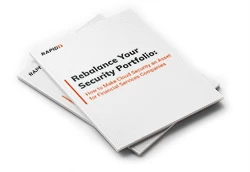Security at the speed of innovation
In the financial industry, digital transformation must be balanced with security. After all, protecting the investments and capital of clients is paramount. Rapid7 offers financial services organizations practitioner-first cloud and hybrid security solutions that support a proactive, shift left approach, automation to scale in a complex environment, and consolidation for simplified compliance and security audits. Keep risks in check to confidently drive your organization’s digital transformation forward.
Cloud Security in Financial Services Makes Sense
When it comes to managing your dynamic cloud environment, a proactive approach is best. Shifting security left and leveraging infrastructure as code (IaC) can help you identify issues early in the development cycle and prevent problems before they happen.
Your cloud environment is getting larger and more complex. Stakeholder changes, software deployments, and rebuilds all help your environment evolve, but also introduce risk. Automated security and vulnerability management can help you auto-remediate, and quarantine risks before they’re exploited.
Financial services organizations are often highly regulated and need to meet strict internal and external compliance regulations. A streamlined cloud security solution simplifies your security ecosystem, creating a single source of truth for conducting audits and maintaining compliance.
Finserv and the Cloud: Laying Secure Foundations While Empowering Transformation
In the financial services industry, digital transformation can be a struggle. Integrating new technology with legacy systems while managing technical debt and securing complex infrastructure is both necessary and frustrating. Regardless of where your organization is at in its digital transformation journey, prioritizing cloud security is key to ensuring your changing infrastructure is protected and supported.
Learn more about implementing cloud security from Rapid7’s VP of Strategic Enablement, Cloud Security, Peter Scott and a panel of security leaders.

Single solution. Unmatched value. Complete coverage.
Cloud Risk Complete delivers world-class cloud security along with unlimited vulnerability management and dynamic application security testing, all with a single subscription. Secure your cloud environment from development to production, and perform dynamic application security testing to remediate application risk.

A trusted name in the security community.
Learn more about reducing risk, leveraging automation, and implementing compliance standards across your organization’s cloud environments with Rapid7’s trusted cloud security resources.

Learn how to drive innovation across your organization without creating risk.

Discover how to put automation into action across your cloud environment.

Find tips to implement compliance standards across multi-cloud and hybrid environments.
Bringing 1700+ financial services companies streamlined cloud security solutions that push their digital transformations further, faster. - View Customer Stories




